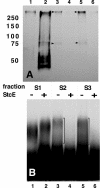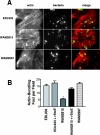The StcE protease contributes to intimate adherence of enterohemorrhagic Escherichia coli O157:H7 to host cells
- PMID: 15731026
- PMCID: PMC1064933
- DOI: 10.1128/IAI.73.3.1295-1303.2005
The StcE protease contributes to intimate adherence of enterohemorrhagic Escherichia coli O157:H7 to host cells
Abstract
Enterohemorrhagic Escherichia coli (EHEC) O157:H7 is a diarrheal pathogen that causes attaching and effacing (A/E) lesions on intestinal epithelial cells. Strains of the O157 serogroup carry the large virulence plasmid pO157, which encodes the etp type II secretion system that secretes the genetically linked zinc metalloprotease StcE. The Ler regulator controls expression of many genes involved in A/E lesion formation, as well as StcE, suggesting StcE may be important at a similar time during colonization. Our laboratory has previously demonstrated that StcE cleaves C1-esterase inhibitor, a regulator of multiple inflammation pathways. Here we report two new substrates for StcE, mucin 7 and glycoprotein 340, and that purified StcE reduces the viscosity of human saliva. We tested the hypothesis that StcE contributes to intimate adherence of EHEC to host cells by cleavage of glycoproteins from the cell surface. The fluorescent actin stain (FAS) test was used to observe the intimate adherence represented by fluorescently stained bacteria colocalized with regions of bundled actin formed on HEp-2 cells. An E. coli O157:H7 strain with a stcE gene deletion was not affected in its ability to generally adhere to HEp-2 cells, but it did score threefold lower on the FAS test than wild-type or complemented strains. Addition of exogenous recombinant StcE increased intimate adherence of the mutant to wild-type levels. Thus, StcE may help block host clearance of E. coli O157:H7 by destruction of some classes of glycoproteins, and it contributes to intimate adherence of E. coli O157:H7 to the HEp-2 cell surface.
Figures




References
-
- Afset, J. E., K. Bergh, and L. Bevanger. 2003. High prevalence of atypical enteropathogenic Escherichia coli (EPEC) in Norwegian children with diarrhoea. J. Med. Microbiol. 52:1015-1019. - PubMed
Publication types
MeSH terms
Substances
Associated data
- Actions
- Actions
Grants and funding
LinkOut - more resources
Full Text Sources
Other Literature Sources
Research Materials
Miscellaneous

